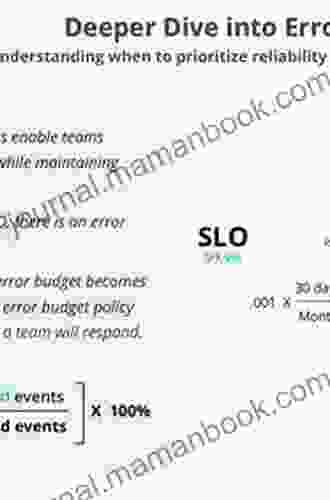Practical Guide to SLOs, SLIs, and Error Budgets

4.7 out of 5
| Language | : | English |
| File size | : | 12992 KB |
| Text-to-Speech | : | Enabled |
| Screen Reader | : | Supported |
| Enhanced typesetting | : | Enabled |
| Print length | : | 581 pages |
In the realm of distributed systems, ensuring the reliability, availability, and performance of services is paramount. To achieve this, it is crucial to establish clear and measurable objectives that define the expected behavior of the system. This is where Service Level Objectives (SLOs),Service Level Indicators (SLIs),and Error Budgets come into play.
This comprehensive guide will provide a thorough understanding of these key concepts and offer practical guidance on their implementation. By leveraging SLOs, SLIs, and Error Budgets, you can effectively monitor your distributed systems, identify and address errors proactively, and ensure optimal performance.
Service Level Objectives (SLOs)
An SLO defines the acceptable level of service that a system should provide over a specified period of time. It is a high-level agreement between the service provider and the consumers of that service. SLOs are typically expressed as a target value and an error budget.
- Target Value: The desired performance level that the system should aim to achieve. For example, an SLO for a web service might specify a target uptime of 99.9%.
- Error Budget: The amount of deviation from the target value that is considered acceptable. It represents the buffer or margin of error that the system can tolerate without impacting the overall service level. Continuing with the web service example, an error budget of 0.1% would mean that the service can tolerate up to 0.1% of downtime per month.
When defining SLOs, it is important to consider the following factors:
- The business impact of service disruptions
- The technical feasibility of achieving the target value
- The cost of implementing and maintaining the SLO
Service Level Indicators (SLIs)
SLIs are metrics that measure the performance of a service against its SLO. They provide objective and quantifiable data that can be used to track the system's progress towards achieving the desired service levels. Common SLIs include:
- Uptime: The percentage of time that the service is available and operational.
- Latency: The time it takes for the service to respond to requests.
- Throughput: The number of requests that the service can handle per unit of time.
- Error Rate: The percentage of requests that result in errors.
When selecting SLIs, it is crucial to align them with the SLOs they are measuring. For instance, if an SLO specifies a target uptime of 99.9%, the corresponding SLI would be the percentage of time the system was actually up and running.
Error Budgets
An error budget is a proactive approach to managing errors and maintaining service levels. It establishes a threshold for the number of errors that can occur before corrective action is required. The error budget is derived from the SLO and the SLI that measures the error rate.
By tracking the error rate against the error budget, you can proactively identify and address potential performance issues before they impact the overall SLO. This allows you to minimize downtime, improve service reliability, and maintain customer satisfaction.
Implementing SLOs, SLIs, and Error Budgets
To effectively implement SLOs, SLIs, and Error Budgets in your distributed systems, follow these steps:
- Define Clear SLOs: Establish specific and measurable SLOs that reflect the desired performance and reliability levels of your system.
- Identify Relevant SLIs: Select SLIs that accurately measure the performance aspects covered by your SLOs.
- Set Error Budgets: Determine the acceptable error rates based on the SLOs and SLIs.
- Monitor and Track SLIs: Establish a monitoring system to continuously track the SLIs and identify deviations from target values.
- Manage Error Budgets: Monitor the error rate against the error budget and take proactive steps to address any potential issues.
- Review and Adjust: Regularly review and adjust the SLOs, SLIs, and Error Budgets as the system evolves and performance requirements change.
Benefits of Using SLOs, SLIs, and Error Budgets
By leveraging SLOs, SLIs, and Error Budgets, you can achieve significant benefits for your distributed systems, including:
- Enhanced Observability: Gain a comprehensive understanding of your system's performance and reliability through detailed monitoring and measurement.
- Improved Reliability: Proactively identify and address performance issues, preventing disruption to critical services.
- Optimized Error Handling: Establish clear thresholds for acceptable error rates, enabling efficient and timely response to errors.
- Increased Customer Satisfaction: Ensure high levels of service quality, leading to improved customer satisfaction and loyalty.
- Reduced Downtime: Minimize the impact of errors and performance issues, resulting in reduced downtime and increased revenue.
In the dynamic landscape of distributed systems, SLOs, SLIs, and Error Budgets are essential tools for ensuring the reliability, availability, and performance of your services. By defining clear objectives, monitoring performance metrics, and managing errors proactively, you can empower your team to deliver high-quality services consistently.
This comprehensive guide has provided you with a roadmap for understanding and implementing SLOs, SLIs, and Error Budgets in your organization. By embracing these best practices, you can enhance the stability, performance, and customer satisfaction of your distributed systems.
Glossary
- Distributed System: A system that consists of multiple independent components that communicate and cooperate with each other over a network.
- Service Level Agreement (SLA): A contract between a service provider and its customers that defines the expected performance and availability of the service.
- Mean Time Between Failure (MTBF): The average time between failures of a system.
- Mean Time to Repair (MTTR): The average time it takes to repair a failed system.
4.7 out of 5
| Language | : | English |
| File size | : | 12992 KB |
| Text-to-Speech | : | Enabled |
| Screen Reader | : | Supported |
| Enhanced typesetting | : | Enabled |
| Print length | : | 581 pages |
Do you want to contribute by writing guest posts on this blog?
Please contact us and send us a resume of previous articles that you have written.
 Top Book
Top Book Novel
Novel Fiction
Fiction Nonfiction
Nonfiction Literature
Literature Paperback
Paperback Hardcover
Hardcover E-book
E-book Audiobook
Audiobook Bestseller
Bestseller Classic
Classic Mystery
Mystery Thriller
Thriller Romance
Romance Fantasy
Fantasy Science Fiction
Science Fiction Biography
Biography Memoir
Memoir Autobiography
Autobiography Poetry
Poetry Drama
Drama Historical Fiction
Historical Fiction Self-help
Self-help Young Adult
Young Adult Childrens Books
Childrens Books Graphic Novel
Graphic Novel Anthology
Anthology Series
Series Encyclopedia
Encyclopedia Reference
Reference Guidebook
Guidebook Textbook
Textbook Workbook
Workbook Journal
Journal Diary
Diary Manuscript
Manuscript Folio
Folio Pulp Fiction
Pulp Fiction Short Stories
Short Stories Fairy Tales
Fairy Tales Fables
Fables Mythology
Mythology Philosophy
Philosophy Religion
Religion Spirituality
Spirituality Essays
Essays Critique
Critique Commentary
Commentary Glossary
Glossary Bibliography
Bibliography Index
Index Table of Contents
Table of Contents Preface
Preface Introduction
Introduction Foreword
Foreword Afterword
Afterword Appendices
Appendices Annotations
Annotations Footnotes
Footnotes Epilogue
Epilogue Prologue
Prologue Marc Alan Edelheit
Marc Alan Edelheit Bill Harris
Bill Harris David L Kirp
David L Kirp Josie Ford
Josie Ford Michael Cain
Michael Cain Brittney Martin
Brittney Martin Andrew Cotter
Andrew Cotter Kay Traille
Kay Traille Alex Hidalgo
Alex Hidalgo Phillip Campbell
Phillip Campbell Francis Jonah
Francis Jonah Ayman Hassan
Ayman Hassan Alex Haley
Alex Haley Kylie Gilmore
Kylie Gilmore James Hilton
James Hilton Katsuo Yamazaki
Katsuo Yamazaki Pk Davies
Pk Davies Kaira Rouda
Kaira Rouda Joann Cleland
Joann Cleland Aleksandra Mikic
Aleksandra Mikic
Light bulbAdvertise smarter! Our strategic ad space ensures maximum exposure. Reserve your spot today!

 Preston SimmonsUnveiling the Enchanting Quirks of the Tale: A Comprehensive Exploration of...
Preston SimmonsUnveiling the Enchanting Quirks of the Tale: A Comprehensive Exploration of...
 Dan HendersonThe Restoration of Old Violins: Advanced Techniques Part Six - General Points
Dan HendersonThe Restoration of Old Violins: Advanced Techniques Part Six - General Points
 William PowellThe Tell-Tale Heart Illustrated New Classics: Journey into the Labyrinth of a...
William PowellThe Tell-Tale Heart Illustrated New Classics: Journey into the Labyrinth of a... Theo CoxFollow ·18.8k
Theo CoxFollow ·18.8k Jean BlairFollow ·15.9k
Jean BlairFollow ·15.9k Donovan CarterFollow ·5.5k
Donovan CarterFollow ·5.5k Jimmy ButlerFollow ·3.2k
Jimmy ButlerFollow ·3.2k Sammy PowellFollow ·11.3k
Sammy PowellFollow ·11.3k Robbie CarterFollow ·5.2k
Robbie CarterFollow ·5.2k Don ColemanFollow ·9.3k
Don ColemanFollow ·9.3k Felix CarterFollow ·12.1k
Felix CarterFollow ·12.1k

 Alexandre Dumas
Alexandre DumasFugitive Telemetry: Unraveling the Secrets of the...
In the realm of...

 Caleb Carter
Caleb CarterBlack Clover Vol 25: Humans and Evil - A Journey into the...
Unveiling the Sinister Forces Black...

 Israel Bell
Israel BellHow to Make Offers So Good People Feel Stupid Saying No
In today's competitive business environment,...

 Simon Mitchell
Simon MitchellWrath of Hades: The Children of Atlantis
An Epic Tale of...

 Percy Bysshe Shelley
Percy Bysshe ShelleyStrengthen Your Immune System: Fight Off Infections,...
What is the...

 Clark Bell
Clark Bell10 Things I Wish Someone Had Told Me Earlier
As we navigate through life, we accumulate a...
4.7 out of 5
| Language | : | English |
| File size | : | 12992 KB |
| Text-to-Speech | : | Enabled |
| Screen Reader | : | Supported |
| Enhanced typesetting | : | Enabled |
| Print length | : | 581 pages |






